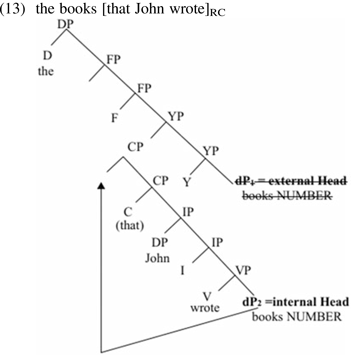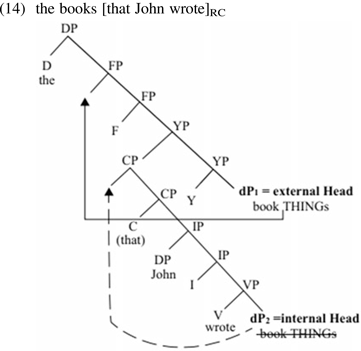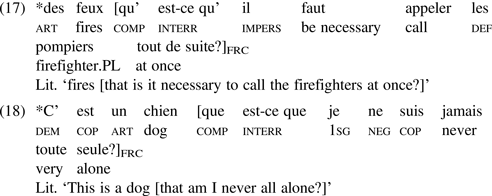1. The Frame Noun-Modifying Clause as a (rarely noticed) type of relative clause
The relative clause (henceforth RC) in question is what Matsumoto et al. (Reference Matsumoto, Comrie, Sells, Matsumoto, Comrie and Sells2017a, Reference Matsumoto, Comrie and Sells2017b) dubbed Frame Noun-Modifying Clause (henceforth FNMC).Footnote 1 Matsumoto et al. establish a typology of noun-modifying clauses based on Eurasian languages in which a modifying clause and a modified noun form a unit. As one of the noun-modifying clauses, the FNMC is characterized by the fact that “the head noun instantiates some other frame element within the clause (not covered by the argument or adjunct)”Footnote 2 (Matsumoto et al. Reference Matsumoto, Comrie, Sells, Matsumoto, Comrie and Sells2017a: 5), for example in Korean (1) and in Hup (Puinavean, Hupdë) (2):

Even though the FNMC does not occur as a type of RC in standard English (see section 3), we will argue that it is indeed a type of RC in the languages where it occurs. The RC is generally understood as a subordinate clause that modifies a head, as for example in:Footnote 3
(3) [the book]head [that John wrote]RC
More specifically, the fact that the RC is a subordinate clause manifests itself in particular in the absence of root phenomena (e.g., word order change, illocutionary force, etc.) and the presence of specific subordinators: for instance (1) and (2) are marked respectively with the subordinate markers -n and -ɔp; and in both languages the modifying clauses must be verb-final, contrary to independent clauses (see Sohn (Reference Sohn1999) for Korean and Epps (2008) for Hup).Footnote 4 As for the semantic modification (i.e., the RC modifies the head), there should be an intersection (whether in terms of “opération de restriction” (Creissels Reference Creissels2006: §32.1) or predication (Heim and Kratzer Reference Heim and Kratzer1998)) between the set denoted by the head noun and the one by the RC, for example for (3):

The intersection is also in operation in the FNMC, for example for (1):

Note that both (1) and (3) are different from non-restrictive RCs and complement clauses in the new set resulting from the intersection: a subset for (1) and (3) and still the same set for the non-restrictive RC and the noun complement clause:Footnote 5
(4) [the books, which John wrote…] = [the books…] & [John wrote the books]
(5) [the conclusion that Pierre is guilty] = [the conclusion…] & [the conclusion is that Pierre is guilty]
Hence, the FNMC satisfies the widely accepted definition of the RC given above, and thus it is indeed a type of RC.Footnote 6 In what follows, we will use F(rame) RC instead of FNMC.
The FRC is attested largely in East Asian prenominal RC languages, including at least Japanese (Matsumoto et al. Reference Matsumoto, Comrie, Sells, Matsumoto, Comrie and Sells2017a), Cantonese (Matthews and Yip Reference Matthews, Yip, Matsumoto, Comrie and Sells2017) and Mandarin, as in (6):

Beyond Eurasian languages, the FRC is rare, though it does exist in a few African languages and Indigenous languages of the Americas, including for example Hup (Amazonian, see (2) above) and Maale (Afro-Asiatic, Omotic), as in (7):

In Maale such RCs are always non-finite – one of the characteristics of subordinate clauses in Maale.
Note that the FRC is not limited to prenominal relativization, but also attested, for example, in Mungbam (Niger-Congo, Bantoid), an African language with postnominal RCs:

It is also attested in non-standard varieties of American English, as in Salinger's The Catcher in the Rye:

and in non-standard varieties of European French:Footnote 8

2. Cinque's (Reference Cinque2020) unified analysis of RCs
Cinque (Reference Cinque2020) proposes a unified analysis for different types of RC, deriving all of them from a single double-headed universal structure via raising or matching. Raising applies in cases where the overt head noun is interpreted (i.e., reconstructed) inside the RC, for example (Cinque Reference Cinque2020: 23):Footnote 9

The internal head (henceforth IH) dP2 and the external head (henceforth EH) dP1 are categorially identical. The IH raises to [Spec, CP], licensing the deletion of the EH. Arguments in favour of reconstruction include binding and sensitivity to islands, among others.
Matching applies if the overt head noun does not or cannot be interpreted inside the RC, whereby there is no reconstruction effect, for instance (Cinque Reference Cinque2020: 36):Footnote 10

More generally, matching is forced when the raising derivation is not accessible, in particular when the EH and the IH are categorially distinct, for example, as in (14), for example: the EH (e.g., dP1) raises to [Spec, FP] and licenses the deletion of the IH (e.g., DP, KP, or DP/KP inside a PP). Importantly, the IH will be realized by a wh-pronoun or wh-phrase, or by a resumptive pronoun or epithet. We will show that Cinque's unified analysis cannot properly account for the FRC.
3. Categorial problem: no place for the FRC in the syntactic typology of RC
The FRC does not fall into any of the RC types discussed by Cinque (Reference Cinque2020). It cannot be the amount RC. It is not the non-restrictive RC, either, in that the FRCs given above clearly narrow down the reference of the head noun. In French, (11)–(12) are formally distinct from non-restrictive RCs, in at least two ways: the head nouns are indefinite and there is no pause (or comma in writing) between the head noun and the modifying clause.
The FRC is not the kind(-defining) RC. Even if the FRC is paraphrasable as N such that in English (e.g., ‘the change such that it is from buying books’ for (1) and (6)) just like the kind(-defining) RC (e.g., He is a guy that (he) gets into a lot of fights, which is paraphrasable as ‘He is such that he gets into a lot of fights’ (Cinque Reference Cinque2020: 184)), the FRC does not exhibit the typological properties recognized for the kind(-defining) RC (Cinque Reference Cinque2020).Footnote 11 Firstly, the kind(-defining) RC does not narrow down the reference of the head, but the FRC in contrast narrows down the reference of the head, as shown in (1'). Secondly, resumptive elements are not admitted in the FRC, contrary to certain kind(-defining) RCs. For example, resumptive pronominals are obligatory in certain RCs in Mandarin (as in (15)) and Mungbam (as in (16)):

In contrast with the RCs, resumptive pronominals are never possible in the FRCs in Mandarin and Mungbam. Thirdly, the FRC, contrary to the kind(-defining) RC, cannot have an independent illocutionary force, for example in French:

This restriction is somewhat relaxed in Mandarin, but still in effect: although the FRC may be a wh-question, polar questions are not allowed:

Fourthly, the FRC cannot retain an IH. For example, even though there are internally headed RCs in Japanese (Ohara Reference Ohara and Hasegawa2018), we find that Japanese head-internal RCs can never be FRCs.
As for the other properties listed by Cinque (heavy pied-piping with the il quale paradigm, agreement with the subject of the matrix clause, compatibility with the presuppositional negative adverb mica), they are language-specific and do not apply to the above languages. Consequently, it is clear that the FRC is not the kind(-defining) RC.
The FRC is not the restrictive RC, either. Take English and French, for example. First, contrary to the “standard” restrictive RCs of English and French introduced either by relative pronouns or by the complementizers that and que, only the complementizers that and que are used in the FRC, and more importantly, they must be used in the non-standard varieties where the FRC is observed, as in (9) and (11), repeated below as (21) and (22):
(21) …and they all had on the kind of hats [*(that) you knew they didn't really live in New York]FRC
(22) des feux [*(qu’)il faut appeler les pompiers tout de suite]FRC
Note that in the same non-standard varieties of American English, the complementizer that is, more often than not, omitted (e.g., in certain non-subject RCs), even in noun complement clauses. Here is a further example from The Catcher in the Rye (§6, last paragraph):
(23) I had a feeling old Ackley'd probably heard all the racket and was awake.
The contrast between the possible zero marking in the noun complement clause and the obligatory use of that in the FRC on the one hand, and the possibility of omitting the complementizer in the noun complement clause and in the non-subject restrictive RC on the other, imply that the FRC is not a restrictive RC.
Secondly, different from the restrictive RC, the FRC is never gapped.Footnote 12 In logic terms, the FRC is not an open proposition. This is particularly clear in English and French examples (9)–(12), even though in English and in French gapping is a priori the most frequent strategy of relativization, or even the only possible strategy in the case of relativizing certain positions such as subject and object. The absence of gap differentiates the FRC from the restrictive RC. All in all, the FRC is not the restrictive RC.Footnote 13
To sum up, the FRC does not belong to any of the RC types enumerated by Cinque (Reference Cinque2020). Even so, a priori this does not automatically imply that it cannot be derived via his raising and/or matching operation(s). However, we will show that neither matching nor raising can be applied to the derivation of the FRC.
4. Derivational problem: when raising raises problems and matching does not match
Given that the overt head noun cannot be interpreted inside the FRC, a priori matching is the only possible derivation. The first issue, though, is that it is difficult to determine how the head noun and the FRC are semantically related unless one is satisfied with descriptives such as ‘frame’ or ‘aboutness’. Semantic indeterminacy leads to syntactic vagueness.
The second issue is that according to Cinque (Reference Cinque2020: 37), in cases where matching applies, the IH can be realized by a wh-pronoun or wh-phrase, or by a resumptive pronoun or epithet, though not cross-linguistically.Footnote 14 However, in none of the above FRCs is the head noun realized by a wh-pronoun or wh-phrase, or by a resumptive pronoun or epithet. As stated above, the FRC is only and must be marked with the complementizers that in English and que in French, although there are indeed wh-pronouns or wh-phrases introducing RCs in these two languages. In Mandarin and Mungbam, contrary to the obligatory use of resumptive elements in certain types of RC, the FRC cannot admit any resumptive elements. In other words, the FRC does not license the relevant wh-pronouns, wh-phrases, resumptive pronouns or epithets.
Third, Cinque (Reference Cinque2020) discusses in great detail the External Merge (EM) positions of the different types of RC, as follows:
None of these positions is adequate for the FRC. In languages in which non-restrictive RCs and restrictive RCs are formally distinct, such as English ((25)–(26)) and French ((27)–(28)), there seems to be no fixed order between the FRC and the non-restrictive RC or between the FRC and the restrictive RC:
(25) the kind of hats [that you knew they didn't really live in New York]FRC(,) [that you even never see in New York]RC
(26) the kind of hats(,) [that you never see in New York]RC(,) [that you knew they didn't really live in New York]FRC
(27) mon chien [que je ne suis jamais toute seule]FRC(,) [que je peux pas vivre un jour sans]RC
(28) mon chien(,) [que je peux pas vivre un jour sans]RC, [que je ne suis jamais toute seule]FRC
The FRC is not necessarily in a lower position than the non-restrictive RC or in a higher position than the restrictive RC. On the other hand, in languages where the restrictive RC and the non-restrictive RC are not formally distinct, such as Mandarin, it seems that the FRC must be nearer to the head noun than the other RCs:

According to Cinque's hierarchy (24), the non-restrictive RC occupies the highest EM position, so the fact that the FRC cannot be higher than any other types of RC in Mandarin imply that the FRC should not be the non-restrictive RC. However, in Mandarin the FRC can be separated from the head noun by a demonstrative, which nonetheless can also appear before the FRC:

Consequently, it remains unclear whether the demonstrative or the FRC is initially merged in a superior position before the latter is raised to an even higher level. But given (29)–(30), the FRC should be externally merged in a relatively low position. Thus, the dilemma is that in Mandarin the FRC must be lower than all the other types of RC, but higher than the demonstrative. One solution consists in proposing other internal mergers in order for the right linear order to be derived properly, but this still leaves unsolved the problem of the EM position of the FRC.
5. Conclusion
To conclude, the FRC, as a particular type of RC, cannot be integrated into Cinque's syntactic and semantic typologies of RCs. The categorial problem aside, the FRC cannot be properly derived, via either raising or matching.
One possible derivation of the FRC is the Head External Analysis (Quine Reference Quine1960, Ross Reference Ross1967, Chomsky Reference Chomsky, Culicover, Wasow and Akmajian1977, Jackendoff Reference Jackendoff1977, Meinunger Reference Meinunger2000): The head originates outside the FRC, which is adjoined to the head. Semantically, the head and the FRC combine via intersective modification. This analysis relies on the controversial head-directionality parameter to account for prenominal FRCs (e.g., (1), (2), (6), (7) and (8)) and postnominal ones (e.g., (9)–(12)). However there is good reason to believe that this is currently the most promising syntactic analysis for deriving the FRC.



